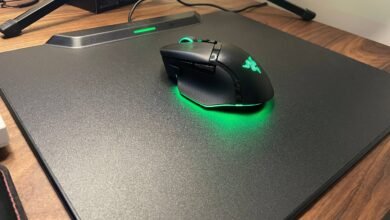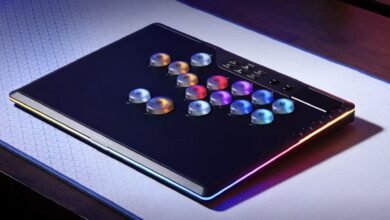Havn BF 360 PC Case Review: Is It Worth It?

▼ Summary
– The Havn BF 360 is a well-designed mid-tower PC case praised for its airflow and cable management, available in black or white colorways.
– It features a traditional layout with front-to-back airflow, a sloped PSU shroud, and supports large components like 420mm radiators and 410mm GPUs.
– The case comes in two versions: the BF 360 Flow with preinstalled large fans for better cooling or a standard version without fans at a lower price.
– Testing showed optimal cooling with top fans configured as one intake and one exhaust, achieving balanced CPU and GPU temperatures without excessive noise.
– Cable management is highly accessible with wide channels, sliding tidies, and a maneuverable GPU support bracket, though the case is notably heavy at 14.79 kg.
The Havn BF 360 PC case delivers exceptional airflow and sophisticated cable management, wrapped in a design that stands out from the crowd. Following the debut of its first case nearly a year ago, Havn returns with the BF 360, a model that may lack the flashiness of its larger HS 420 sibling but matches it in performance and intelligent engineering.
Available in both black and white, the BF 360 features a distinctive textured front panel that first caught attention at Computex. While the white HS 420 is striking, the black BF 360 arguably presents a more cohesive aesthetic, with its lighter front panel creating a pleasing contrast against the dark chassis. The design language established with the HS 420 continues here, characterized by rounded corners and extensive venting along the front, top, and rear panels to maximize air movement. Although the rear panel lacks the venting found on the HS 420, a feature some described as air conditioning-chic, the BF 360 remains a visually appealing case that captures the essence of its predecessor without the expansive panoramic window.
Key specifications for the Havn BF 360 include a mid-tower form factor measuring 515 x 254 x 522.6 mm and a substantial weight of 14.79 kg. It supports up to seven fans (three on top, three in front, and one rear) and accommodates radiators up to 420 mm at the top. Graphics cards up to 410 mm in length will fit comfortably, and CPU air coolers up to 195 mm tall are supported. The front I/O panel provides two USB 3.2 Type-A ports, one USB 3.2 Type-C port, and a standard audio jack. Consumers can choose between the BF 360 Flow version with included fans for approximately $180, or a standard version without fans for around $160.
In a market saturated with fishtank-style cases, the BF 360’s traditional mid-tower layout feels almost refreshing. Its design prioritizes straightforward front-to-back airflow, aided by a sloped PSU shroud that helps direct cooling air from the front fans toward the graphics card. One aspect not fully conveyed in product images is the case’s considerable width, which becomes apparent when viewing the spacious area surrounding the power supply. This generous internal volume allows for extensive hardware compatibility, including large liquid cooling radiators, lengthy graphics cards, and tall air coolers.
The BF 360 Flow version ships with two pre-installed 180 mm H18 fans at the front and a single 140 mm H14 fan at the rear, all connected to an integrated fan controller. There is additional space for up to two more 180 mm fans on the top panel. While the H14 and H12 (120 mm) fans are available separately in both black and white, the H18 fans currently come only in black. Independent testing of the H12 fans confirms their strong performance across a broad RPM range, with commendable airflow and manageable noise levels. For most users, the Flow version with its larger, more effective fans represents the better value.
A minor drawback involves the front fan bracket. The standard BF 360 includes a versatile bracket supporting various fan sizes, but the Flow version omits this component. This could pose an inconvenience for anyone considering a switch from the unusual large fans to more conventional sizes later on. Given the case’s premium positioning, including this bracket with both models would be a welcome improvement.
Thermal performance was rigorously tested using multiple configurations. With a Ryzen 7 9800X3D processor and an RTX 4080 Founders Edition graphics card, different top-fan arrangements were evaluated during runs of Metro Exodus Enhanced Edition. The most effective setup used one top fan as intake and the other as exhaust, yielding average temperatures of 56°C for the GPU and 55°C for the CPU. Configuring both top fans as intake raised GPU temperatures to 59°C, while setting both as exhaust increased CPU temperatures to 60°C. Running the front fans at maximum speed reduced GPU temperatures by an additional 2°C, though the accompanying noise increase makes this impractical for daily use.
Removing the magnetically attached front panel, a single unit combining wide vents and a fine dust filter, increased airflow velocity over the RAM from 2.4 m/s to 2.8 m/s, a typical result that indicates the panel does not significantly impede cooling. Overall, airflow is a definite strength of the BF 360. Even without extra top fans, installing a liquid cooler in the upper position maintained excellent temperatures, with the tested Cooler Master unit keeping the GPU at 55°C and the CPU at 51°C on average.
Cable management in the BF 360 is exceptionally user-friendly, with wide routing channels, sliding cable tidies on rubber grommets, and ample space behind the motherboard tray. The sloped PSU shroud further simplifies organization, and the 3.5-inch drive bays are conveniently mounted beside the motherboard tray rather than underneath it. Each bay can hold two 2.5-inch drives or one 3.5-inch drive and is easily removable with a single thumbscrew. A highly adjustable graphics card support bracket provides sturdy reinforcement for heavy GPUs, though the placement of the USB 3.0 header on some motherboards may require careful maneuvering.
Potential buyers should consider a few key points. The BF 360 is an excellent choice for those seeking powerful airflow with low acoustic output, especially the Flow version with its large, efficient H18 fans. However, it is not a compact case, its dimensions are more substantial than they appear, and the weight can be considerable. A fully assembled test system tipped the scales at 23.6 kg, making it a challenge to move frequently.
With its unconventional aesthetics and meticulously planned layout, the Havn BF 360 has much to offer. The final decision often comes down to value. At its current price point, alternatives like the Arctic Xtender, Asus ProArt PA401, Phanteks Eclipse G400A, or the new Corsair Frame 4500X provide competition, though they may not match the BF 360’s premium feel and distinctive design. For builders tired of ubiquitous fishtank cases and seeking a minimalist, high-performance enclosure, the BF 360 is a compelling option that combines form and function effectively.
(Source: PCGAMER)





